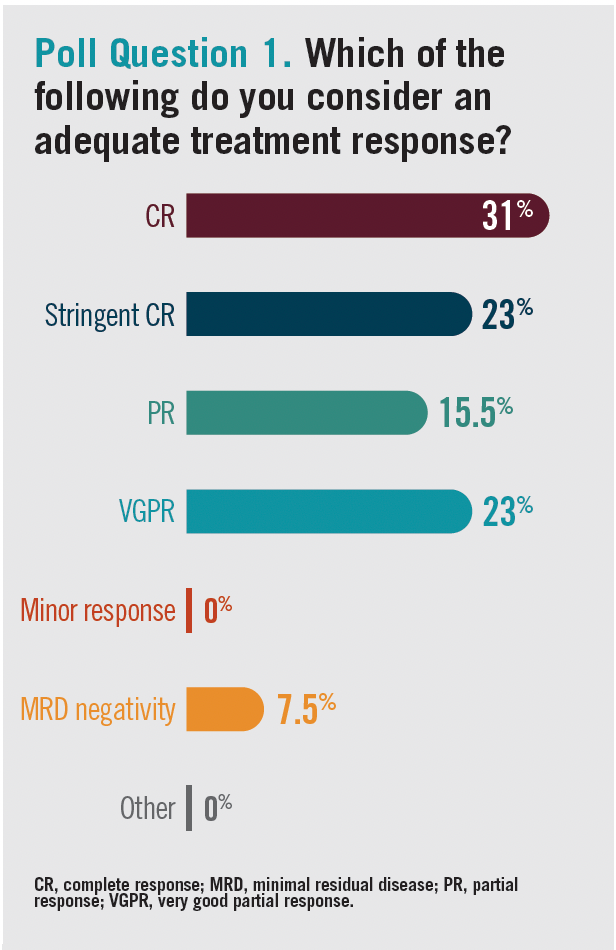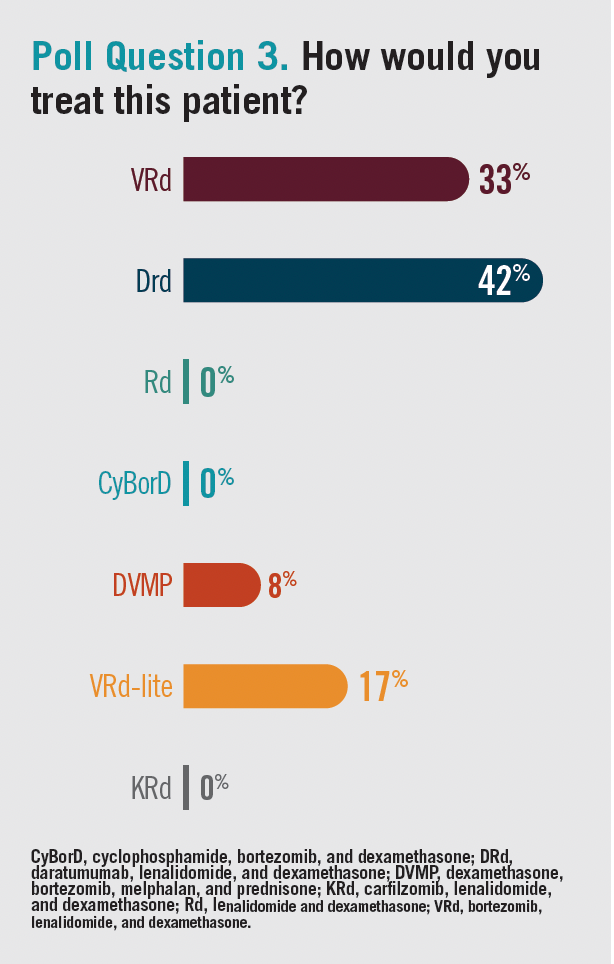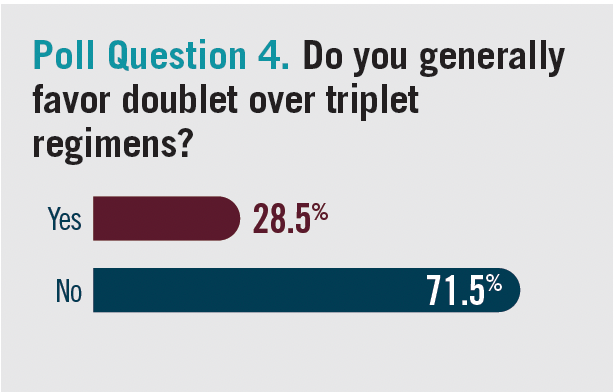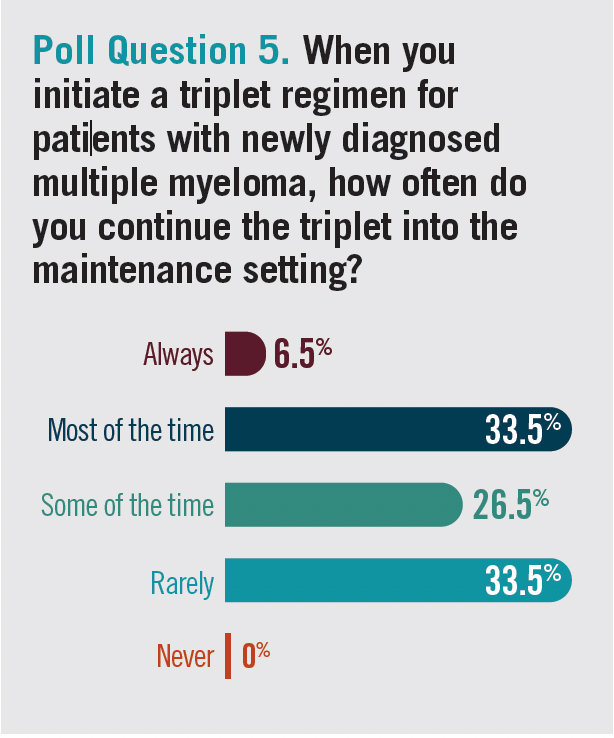Management of Transplant-Ineligible Multiple Myeloma
Experts provide their recommendations for navigating a large and continuously growing treatment landscape, selecting between regimens, and monitoring patients with transplant-ineligible multiple myeloma.

At an Around the Practice presentation hosted by CancerNetwork®, experts discussed improving outcomes for this patient group using a patient case as an example and posing audience polling questions. The panel was led by Robert Z. Orlowski, MD, PhD, professor of medicine, Florence Maude Thomas Cancer Research Professor, and director of myeloma in the Departments of Lymphoma/Myeloma and Experimental Therapeutics in the Division of Cancer Medicine at The University of Texas MD Anderson Cancer Center in Houston.
The expert panel included Larry Anderson, MD, PhD, associate professor in the Department of Internal Medicine in the Division of Hematology/Oncology at UT Southwestern Medical Center in Dallas, Texas; Caitlin Costello, MD, assistant professor of medicine at the University of California, San Diego; and Jeffrey V. Matous, MD, member physician at the Colorado Blood Cancer Institute in Denver.
Goals of Therapy
To kick off the discussion, the panelists reviewed their goals for treatment in patients with newly diagnosed, transplant-ineligible multiple myeloma (MM).
Anderson: The ideal treatment response would be MRD [minimal residual disease] negativity.
Matous: Getting the deepest response possible but avoiding toxicity is my goal. When I think about treatment response, I think complete response [CR]; however, you want to define that. That’s a good goal in treating this population. In years past, we didn’t have regimens that got us there often, but now we can be greedier, trying to get the best response possible. It’s always important, though, to balance that with toxicity concerns in this population.
Costello: I take into consideration many aspects—the patient’s health, the patient’s disease—and then practical things: Why is the patient transplant ineligible? Is it because of medical comorbidities? Is it because they don’t have a social support system? Is it because they’re old and frail? All those characteristics and concerns and questions help gauge what your treatment of approach will be. Of course, we want as deep of a response as possible but also need to make sure we’re considering what the patient’s goals of care are because I can continue to treat and make the numbers go lower and lower, but at what cost? We need to think about the patient and the disease when we’re making decisions and what our goals of treatment and response should be.
Orlowski: If I could pull out one other suggestion for this transplant-ineligible group, it would be to try to reduce their disease-related symptoms. Of course, we want to get CR and MRD [negativity] in everybody if we can, but in this older, more frail population [that is] probably not going to be able to tolerate 4 drugs and may not even be able to stay on 3 drugs for an extended period, the more rapidly you make them feel better, the more likely it is that they’re going to be able to continue on treatment and then, hopefully, get to MRD negativity.
Myeloma Disease Monitoring and Response Evaluation
Costello said she assesses multiple factors when deciding how to fit a patient to an appropriate treatment plan.
Costello: You need to take a step back and look at the patient as a whole and make sure you’re being complete and thorough in evaluating the extent of disease, understanding...the variety of ways that can affect a patient’s body.
Matous: In a transplant-ineligible patient, I rely mostly on serum markers and urine markers. [For] patients who present with symptomatic bony disease, I like to repeat imaging to assess my response with using imaging techniques as well. I’m less likely to repeat a bone marrow biopsy in a transplant-ineligible patient just to see how we’re doing. That’s why, even though I always wished for MRD negativity in my own practice, I don’t try to reach that in my transplant-ineligible patients. I rely on imaging studies when appropriate and serum and urine markers.
I won’t repeat an imaging study. For example, for a CT-PET scan that at baseline showed a hypermetabolic disease, I’ll wait until I get a good response based on serum markers before I repeat that study—and usually not before 3 months as long as my patient is responding clinically. If they say, “My bone pain is a lot better,” then I’m going to feel less of an imperative to repeat the study sooner. If they’re still complaining of pain and I’m not sure if my therapy is doing what I want it to do, I might do the study sooner.
Anderson: If we’re talking about some of the folks who might be more functional and mostly chose to defer transplant, then I might follow those patients with more of these studies to make sure they’re doing OK without needing the transplant. That might be a situation when we consider doing a bone marrow [biopsy]. Looking at MRD for these patients, if it’s because there’s no chance they’re doing a transplant, then I’d stick with the serological methods, watching the M-spike [monoclonal spike] and light chains. If they had baseline imaging, [I will also] follow that up. We don’t necessarily have data if they don’t have a very deep remission, change therapy, or anything like that. I’m at least making sure that their response is going to be durable. But for these more infirm patients, I use serological studies.
Matous: I’m still trying to get my arms around what to do with MRD information. We know it’s good to be MRD negative in a sustained fashion, but do we know what to do with patients who don’t obtain MRD negativity? I struggle with that.
Costello: Every trial nowadays has MRD as an end point, and we’re waiting for those end points. We’re seeing more and more that MRD has a role, but you asked the question of what to do if [the patient is] not MRD negative. Let’s pose the opposite question of what if you are. We don’t have an answer for that either. Does that mean we can use therapy? If you’re MRD negative, does that mean you’re done? If you’re MRD positive, do we have to push harder? There are no good answers.
We all talk about checking it—we need to know—but I don’t do it all the time because I don’t know what to do with it. Outside a clinical trial, and particularly for our community oncology colleagues, I’m not sure it’s practical or realistic to have a role in clinical care.
In a polling question, the audience indicated that CR was the greatest indicator of adequate treatment response, followed by either stringent CR or very good partial response and then partial response
(poll question 1).
Poll Question 1. Which of the following do you consider an adequate treatment response?

Orlowski: If a patient achieves what you consider to be an adequate treatment response, what’s your next step? Let’s say you’ve given a patient induction and whichever definition of response you’re looking for, you reached that. What would you do?
Anderson: It depends on which therapy it is and how they’re tolerating it. After a certain number of cycles, we’d typically pare down the therapy but continue if they’re responding. The data we have are that the patients who stay on therapy the longest tend to have the longest remissions and best outcomes, so we’ll want to keep them on therapy.
Costello: I talk to patients about what their goals are. Are they interested in aggressive care? Are their goals of quality of life just the same? I can always do more. It doesn’t mean I should. Realistically, if someone is doing well on therapy but has not had an adequate response and is interested in pushing further, then it’s reasonable to change therapies.
In a polling question, the audience indicated that in a patient who achieved an adequate treatment response, they would continue the therapy as is (poll question 2).
Poll Question 2. If a patient achieves what you consider an adequate treatment response, what is likely to be your next step?

Managing a Case of Newly Diagnosed, Transplant-Ineligible MM
In the next section, the panelists talked about optimizing frontline therapy in a patient with newly diagnosed, transplant-ineligible MM.
In a polling question, audience members indicated they would favor treating this patient with daratumumab (Darzalex), lenalidomide (Revlimid), and dexamethasone (DRd) (poll question 3).
Poll Question 3. How would you treat this patient?

Anderson: A monoclonal combo like DRd would be my typical choice for patients who are either not transplant candidates or don’t want to transplant because we have excellent deep remissions in most of these patients. It is very well tolerated and doesn’t cause neuropathy. That’s what I would do.
Costello: The t(11;14) immediately makes you think of venetoclax [Venclexta] as a good option, but it’s not approved by the FDA [in this setting]. Remember this person also has type 2 diabetes. They didn’t give us any information about the [glycated hemoglobin] A1C to know how controlled it is or to what degree of peripheral neuropathy may have been associated with it. A proteasome inhibitor is an excellent drug for high-risk cytogenetics, like a deletion 17p.
Heart disease is [making me shy away from] Kyprolis, or carfilzomib. For someone with underlying disease, we’re all nervous about the cardiotoxicity that comes with carfilzomib. We have risk-mitigation strategies of trying to assess who would be a good candidate for carfilzomib and who we may otherwise have some concerns with. But if we monitor those patients closely, heart disease shouldn’t cross carfilzomib off the list.
In a polling question, audience members indicated that they would favor a triplet vs a doublet regimen in this treatment scenario (poll question 4).
Poll Question 4. Do you generally favor doublet over triplet regimens?

Anderson: You could argue, especially in these older patients, that you want to put your best foot forward. Some of these patients may not get to second-line [therapy], especially if they’re more informed. If you can get them on a good regimen up front that’s well tolerated and keep them in remission longer, that might be all they need. Certainly, you’ve got pomalidomide [Pomalyst] and other options as well, even if you don’t have the daratumumab left for later. One other consideration would be doing a couple years of therapy if it’s someone who didn’t have super-aggressive disease. If they relapse again, they would theoretically be sensitive to it again. I’m not too worried about using the daratumumab up front in these patients because we want to get them in a deeper remission and, hopefully, more durable response.
Costello: We have enough survival data out there of triplet vs doublet to tell us that 3 drugs matter. I’d have to have a good reason to not give someone 3 drugs. I could come up with a scenario in my mind where I had an older, frail, bedbound, housebound patient, [and] if I had to come up with something that was an all-oral option, financial toxicity is a consideration. If you’re looking for triplets that are all oral, that’s a lot of expense. If you tried to do it with, for example, lenalidomide for a newly diagnosed, transplant-ineligible patient, they may not have the capability of paying for it from Medicare or [coming] in for regular blood toxicity assessment. I could imagine a scenario where a doublet may have a role, but we have enough data to tell us now that triplets are the appropriate approach.
Orlowski: Sometimes we run into folks who have had lots of thromboembolic complications, and we worry about using an IMiD [immunomodulatory drug] and a steroid. Would you treat with bortezomib and dexamethasone in that kind of patient, or would you think about CyBorD [cyclophosphamide, bortezomib, and dexamethasone]?
Matous: With a thrombotic history, it depends if they’re on anticoagulation. If I can safely anticoagulate the patient, then I have no problem using an immunomodulatory drug. We should make every effort to get a triplet into people, but there are patients who are going to get doublets. Some of us don’t see frail patients who are 85, 90, or 95 years old. We tend not to see those patients. Typically, if patients can come to see us, they’re probably triplet eligible.
Orlowski: How do you factor in frontline therapy, and how does it impact the options and choices for maintenance and later lines of therapy?
Anderson: It depends on what you use for the front line. If you’re using a tolerable regimen, we can potentially keep them on that for maintenance, like a monthly injection for daratumumab. Trying to keep them on therapy, I would often reduce the IMiD after a while. We’ll often get rid of, or at least reduce, some of the steroids after a year or so to help keep these patients on treatment without too much toxicity. Certainly, it depends on when they relapse, what they’re on at the time, and how long it’s been since a previous regimen. If they’re relapsing on a certain class, then you’d want to switch classes at relapse or switch 1 of the drugs, if not both. It also depends on how bad their cytopenia is. If they’re having trouble tolerating IMiDs altogether, you might completely switch drugs. If they’re tolerating it well and just having a slow biochemical relapse, you might consider switching out a drug in the same class.
In a polling question, audience members indicated they would most likely continue triplet therapy into the maintenance setting (poll question 5).
Poll Question 5. When you initiate a triplet regimen for patients with newly diagnosed multiple myeloma, how often do you continue the triplet into the maintenance setting?

Costello: We’re talking about a patient who doesn’t go to transplant and is going to stay on continuous therapy for as long as they can tolerate if it’s working. Many of us who are referring to doublets are talking about dexamethasone plus something else as opposed to 2 active drugs plus or minus dexamethasone. I’m comfortable with patients who are on long-term continuous therapy dropping the dexamethasone. That’s the least active of the triplets that we do and the most active in terms of toxicity. If I can keep people on a monoclonal antibody plus or minus lenalidomide or a proteasome inhibitor, I’m going to try and keep the doublet of the 2 most active drugs. We’ve seen from the MAIA trial [NCT02252172] that that’s practical.1 We’ve seen that we can keep patients on therapy for a very long time. There are maintenance data posttransplant saying we can get people off the dexamethasone. The SWOG-S0777 study [NCT00644228] also looked at trying and get people off dexamethasone.2 We should be trying to do that because that’s often the biggest thing that affects quality of life.
Matous: [For me,] the dexamethasone is the first thing to go. That shortens your clinic appointments by 10 minutes each time you see the patient. I try to keep both drugs going in a certain setting, like DRd. The more challenging question is: What do you do with an VRd or VRd-lite? Eight cycles are what they gave in SWOG-S0777. If you gave 8 cycles in those patients, what do you do with those patients after that?
Orlowski: What is your approach to determining duration of treatment for multiple myeloma?
Anderson: Based on the MAIA and SWOG-S0777 studies, treating until progression is the key to getting longer progression-free survival [PFS] and overall survival. Unless they’re having horrible toxicity, I would try to treat until progression.
Matous: There’s an art to treating to progression. It requires [having] a lot of clinical skills, listening to your patient, educating your patient about the toxicities they should...look out for, and encouraging them to voice those. Keeping people on longer treatment is an art.
Costello: It is an art. If we’re going to try and extrapolate as best as we can for our transplant-ineligible population by looking at the transplant-eligible population, there’s a lot of transplant studies out there that have shown that continued treatment along the course leads to continued improvement in the depth of response and remission times. As best as we can, we must extrapolate to say that more is better.
Orlowski: I’d like to reiterate that transplant-ineligible patients don’t go from first-line to second-line [treatment as often]. Unfortunately, toxicities or complications occur. In the younger patients, more people may go from first line to second line. In a setting where we still, unfortunately, lose some people before they get to second line, it’s important to go with your best guns up front and hopefully have the best impact for the patient.
Counseling Patients
Orlowski then posed a question to the group about the patient case: If after 5 to 6 cycles of treatment with DRd, the patient achieves a very good partial response, tolerates treatment, and decides they want to stop therapy, what is the best way to handle that situation?
Costello: It is a discussion to understand [why they want] to stop. This case says it was tolerated well, but is the patient wanting to travel? Is the patient having trouble with diarrhea related to lenalidomide?
We know we want patients to stay on therapy as long as possible, so if there are any little tweaks, I want to interfere with their life as little as possible. In this marathon we’re running together, how can we make it so that the drugs are not worse than the disease? Oftentimes their symptoms have improved, and now they’re taking drugs and feel fine and are wondering why they’re still taking drugs.
References
- Facon T, Kumar S, Plesner T, et al; MAIA Trial Investigators. Daratumumab plus lenalidomide and dexamethasone for untreated myeloma. N Engl J Med. 2019;380(22):2104-2115. doi:10.1056/NEJMoa1817249
- Durie BGM, Hoering A, Abidi MH, et al. Bortezomib with lenalidomide and dexamethasone versus lenalidomide and dexamethasone alone in patients with newly diagnosed myeloma without intent for immediate autologous stem-cell transplant (SWOG S0777): a randomised, open-label, phase 3 trial. Lancet. 2017;389(10068):519-527. doi:10.1016/S0140-6736(16)31594-X
EP: 1.Goals of Therapy for Transplant-Ineligible MM
EP: 2.Strategies to Monitor Multiple Myeloma
EP: 3.Frequency of Measuring Treatment Response in MM
EP: 4.MRD Testing in Multiple Myeloma
EP: 5.Managing Adequate/Inadequate Treatment Response in MM
EP: 6.Managing A Case of Newly-Diagnosed Transplant-Ineligible MM
EP: 7.Triplet Vs Doublet Therapy for Transplant-Ineligible MM
EP: 8.Maintenance Therapy for Transplant-Ineligible MM
EP: 9.Transplant-Ineligible MM: Treating to Progression
EP: 10.Transplant-Ineligible MM: Reinitiating Therapy
EP: 11.Counseling Patients With MM About Treatment Duration
EP: 12.Transplant-Ineligible MM: Navigating Treatment Challenges
EP: 13.Management of Transplant-Ineligible Multiple Myeloma
Navigating AE Management for Cellular Therapy Across Hematologic Cancers
A panel of clinical pharmacists discussed strategies for mitigating toxicities across different multiple myeloma, lymphoma, and leukemia populations.